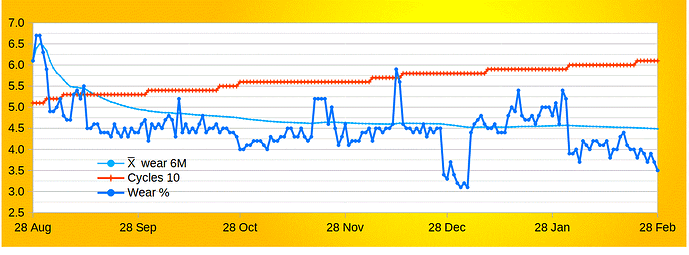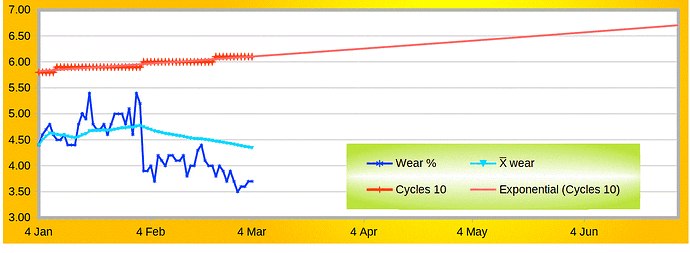That’s how I’ve been doing it essentially since I bought it ~1 year ago. It’s getting really tiresome tbh.
When charging I just check the state by pressing the power button briefly, been doing that for over two years on my FP3s; not tired yet ![]()
Occasionally it reaches 100%, maybe once a month, but that isn’t going to wreck the battery etc.
In fact if you go by the recorded wear, it is arguable that it can reduce the wear…
I have been testing another battery on my laptop for nearly a year and every month or so I charge to 100% fo a few days, rather than the 78% I have set in the limiter.
Here is the data and latest graphs
Then you will probably need root and ACC as Magisk module
I am surprised battery sustainability gets so little attention,
because batteries with their needs for rare earths surely are the part which use most environmental resources.
Samsung or Sony and I think now also Apple have inbuilt battery-safer-modes which steer charging to the most sustainable times,
so I know that what I ask for is possible!
Your support told me that the best usage for the battery would be to keep it charged between 20-80%, so I tried out several apps for it.
Unfortunately, without rooting the phone, those apps only can warn you to charge the phone which sometimes is not heard and is really tedious and often comes at inconvenient times when using it fulltime daily.
So I already wrote to the Fairphone-support, suggesting to build that feature into the phone; but the answer I got was that users would not like it if they want the full accu-range.
However - for users who often stay at home, such a feature could be very valuable when using the 20-80% mode either as a “sustainable-battery-spare” mode, and when going out being able to switch it to “turbo-power” mode which charges the entire 100% and goes down to zero.
All I would love to do is to connect my phone to the charging cable and have a peace of mind without all that nagging hassle of connecting and disconnecting it multiple times daily.
In the past some desktop-computers had such turbo-modes.
I think especially Fairphone with its emphasis on environmental sustainability should implement this feature to make batteries last longer.
Yeah, i’d like such a feature as well. I was rooted before, but gave up with the upgrade (i’m running LOS, though), but in general, this would be a nice feature. And i can’t follow the reasoning, as the modern Samsung my wife is using has this feature (check box 'battery health*or something like that, reportedly, there are more manufactures building that in. Probably for escaping possible regulations regarding sustainability). It’s also in the iodé OS, so i thought about porting it to LOS, but this goes over my head… I bought a hardware device (chargie.org), but that’s a kinda expensive solution…
Do they not know about the existence of toggles? ![]()
Please note that this is a community forum. There is only a very little chance that a FP employee (with the authority to change this behavior) will notice this post.
Moved your post here, its actually a repeated discussion. Smart charging is implemented e.g. in Iode OS. How or if possible in a Google certified OS, I dont know…
Well, Samsung does it. It is certified, even if Samsung does a lot of strange/bad things. At least that’s a good solution, as typically there’s no replaceable battery (except for much money…)
Smart charging is implemented e.g. in Iode OS.
This is really interesting ! Since I am a newby I ask: Is it possible to install iode.tech on a fairphone?
I would do it for the charging feature alone, but also for the Google-protection.
Yes it def is possible to install on the FP4
Edit: best is to ensure the security patch level is same or higher as for FPOS installed, just to avoid bricking…
However I think Iode has implemented other steps to prevent bricking
Well in the case of Fairphone, the answer is quite simple.
Fairphone seems to only aim at being fair with the workers. Doing environmentally friendly choices is frankly something they have no interest in. This is evident by the fact that the bootloader bricking bug is still around after over a year.
The code for this feature is already supplied open sourced by other projects. I somehow doubt implementing it would be very difficult for a competent team of developers.
I doubt that charging exactly to 80% has such an impact on the lifetime of a battery outside a laboratory, that you can call a company not environmentally friendly, it it doesn’t offer such an option.
The battery is constantly taking damage when it’s charged over 80%. Sitting at 100% for almost 8 hours in a row when the user sleeps just isn’t good for the battery.
Here’s a study on car batteries:
https://www.sciencedirect.com/science/article/pii/S2352484719310911
We are not talking about electric cars.
And I know the theory and the laboratory tests. But in real life, I’m most of the times charging to 100% and can still use my batteries for many years. So why bothering with these settings?
And doing it doesn’t make a company or a person ‘environmentally unfriendly’ while doing it makes it the opposite. The world isn’t that black and white.
As Incanus has said it’s not that simple, lab test, car batteries, are way off line for phone use.
The problem with a battery is the rate of charge which causes heat, the expected wear is through the number of cycles is standard to all batteries.
So rapid charging creates heat as does trying to drain a battery below it’s optimum level, which in this case is 3.85V
Charging slowly to 90% or more shouldn’t be an issue much less so that charging rapidly at 60%, but it depends upon the temp.
If the phone is in a warm place or being used, or in anyway is warm then rapid charging can only increase the heat significantly.
So from my own stress tests I can see the difference between the force required to charge i.e. the voltage and the state of charge.
However this is not a lab test and I am only using the date supplied form the phone, but surely that must be the best as that is what a user relies on when charging.
From the graph below you can see the stress as the relationship between the force (voltage) that generates heat and the SoC
The purple line is a function of the voltage, the blue column is the voltage times 10
The SoC is the red column
You can see that when the SoC is around 50% and the voltage 3.8 approx there is an increasing disparity between what force is available and what power A/W SoC is available.
Similarly when charging, the upward lines you can see a huge disparity between the force used to increase the SoC
Both disparities show stress and heat.
From the few tests I have done it seems the optimum range is 50% to 90%
I hope you are joking? Do you think car batteries are somehow magically different, even though they are essentially just larger lithium-ion batteries? The study even states the goal is to measure lithium-ion batteries rather than electric car batteries in particular:
Therefore, a better understanding of Lithium-ion (Li-ion) batteries, since they represent the heart of the majority of electric cars, during the discharging and charging procedure is crucial.
?
Just because you can use it for “many years” doesn’t mean the battery wouldn’t be a lot better if you didn’t charge it to 100% every single night and then keep it there all night.
You could drop your phone every day and it would probably be fine, it doesn’t mean it’s a good idea to do so.
Not a joke
The results show that losses, during charging within the abovementioned area, are almost double compared to the 20%–80% SoC area and vehicle’s average specific real energy consumption is almost 2 kWh/100 km more, compared to what the driver sees on the EV’s dashboard. Furthermore, it is not for the driver’s benefit to exceed 80% of SoC during charging, considering the required charging time, the distance that each SoC area provides and the life expectancy of the battery itself.
That’s just a statement with no data or parameters and as indicated
“it is not for the driver’s benefit to exceed 80% of SoC during charging, considering the required charging time”
It’s the fast charging that is the issue and at 80% that will heat up the batteries especially given how many cells there are in a confined space. Cell at the centre get hot.
A phone battery has a different environment and different use so the 80% ceiling is not helpful for everyone, but sure a fast charge to 80 and not 100 may reduce the prolonged heat damage but a slower rate to 90 will probably result in less damage.
Again the 20 to 80 is to get max charge quickly, but below nominal voltage that equates to 50% there’s stress and heat.
use below 50% that’s even moderate drain can be as damaging as rapid charging at any SoC
Who said I’m loading all night? I only said I’m loading until 100%. And there is degrading over the time anyway, so Li Ion batteries wont last over your complete lifetime.
BTW there is no need to behave rude or aggressive.
Yep, no joke … (like @anon9989719 already outlined above)
One lithium ion battery is not necessarily like any other lithium ion battery.
There are several different li-ion batterie technologies out there and depending on the use (electric vehicles (EV) vs mobile devices; high performance EV vs. long lifespan EV vs. short-range EV vs. etc. …)
Here´s just a very basic overview about the six major types of Li-ion batteries
Don’t worry so much about it. In my experience it’s overrated to be so careful. My old Pixel 3 was absolutely abused battery wise. Wireless charging the whole day, which made it also very hot. In the end the percentage of battery health was the same as someone else that bought the phone around the same time and was anxiously charging all the time. It for sure helps. But netto benefits are not worth it. But YMMV of course.


